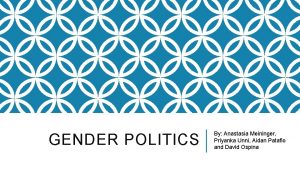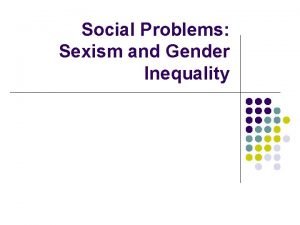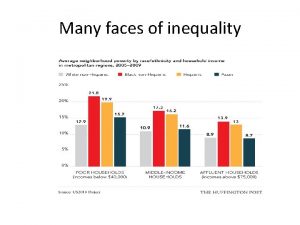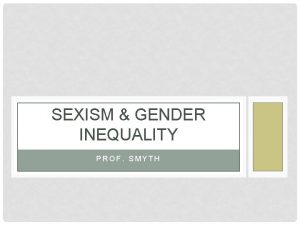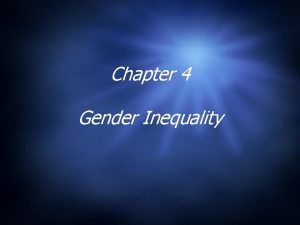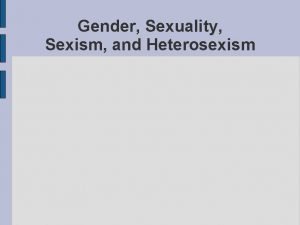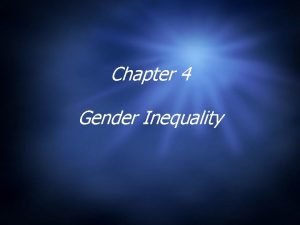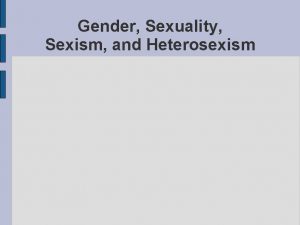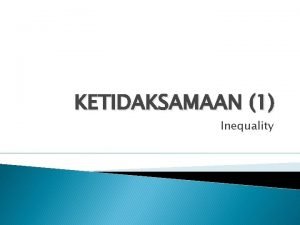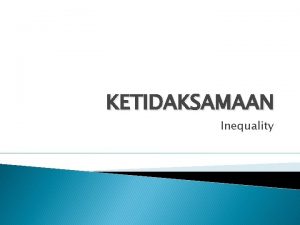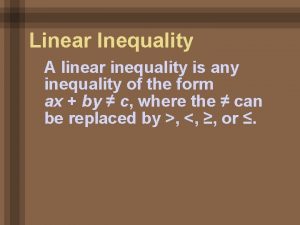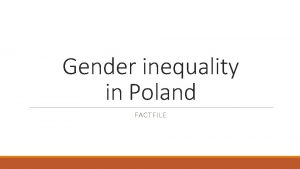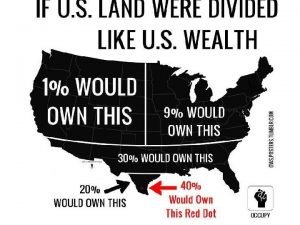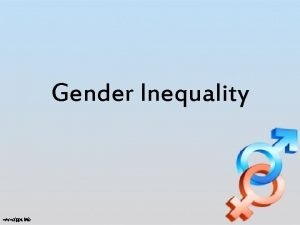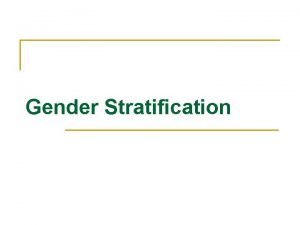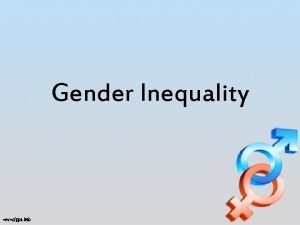Gender Inequality How were women seen n n























- Slides: 23

Gender Inequality

How were women seen? n n n Male property Rape in marriage- dismissed Woman’s place- in the kitchen, b/w the sheets Working women- irresponsible or embarrassment Unwed mothers- stigmatised/shunned University- where to find a man

And now… n n Decide if and when to have children Raise children on their own or with partner Suing employers for harassment/discrimination Exerting pressure on hidebound institutions - embrace female realities or risk credibility The change from then and now is referred to as the:

Reality n n Women still have a long way to go before attaining, economic parity, social equality, agenda setting powers and political power sharing. Progress – yes Equality –no Stereotypes still exist: women are perceived as passive, emotionally soft, and obsessed with appearances Men are perceived as assertive, ambitious, competitive and goal oriented

ASSUMPTIONS ABOUT GENDER (Characteristics according to Fiske) Masculine Feminine active passive presence absence independent organized scattered rational emotional logical illogical intellectual intuitive/imaginative

Gender as a Social Problem Gender relations are unequal relations with respect to: power, privilege, and property. Gender is a social problem when inequities continue to persist in a society that espouses gender equality Gender is problematic because of the growing estrangement is not without consequence -When the scripting of masculinity and femininity into rigid roles and stereotypical rules restrict personal choice, foster sexism and create unequal outcomes

(De) Constructing Gender • Fleras argued that, due to the feminist movement and changes in the n n n workplace the interest in the politics that define male /female relations has been escalated in recent years. Women in male dominated domains have drawn public attention. Individuals express interest in meaning of womanhood/ manhood while sociologists argued that neither is biologically constructed; it is socially and culturally constructed. Masculinity is based on the attributions of a typical male. While femininity exemplifies the cultural characteristics that define the blueprint for female.

A Gender Society n n n n Gender culturally defines who and what we should be in society. It is a label that is assigned to us and this varies culturally. It has shaped our thoughts about how we see ourselves and our relationship with the world. Media images and sanctions have conditioned the minds of children and adults with dominant ideals of masculinity and femininity likewise how they should act as man and a woman. Gender determines pattern of entitlement and engagement of inequality, hierarchical distinctions and advantages. Public perceptions of gender have been altered by 30 years of social upheaval. a) Women were no longer dismissed as inferior or submissive in status b) Roles are not nearly as rigidly scripted as before c) Rules defining masculinity and femininity are increasing contested d) Differences among women are accepted as empowering.

Double Standard n n Men have to renegotiate their relationship with women on the basis of equality. Men are not permitted to show emotions; they will be precluded from female- dominated professions. Discouraged from working with children and criticized by his male counter parts for being wimpy. Females are no longer seen as weak and vacillating rather seen as valuable team worker within the workplace. This has created an identity crisis, because men have lost their spot in the lime-light and they have to find themselves and what is expected of them.

The Masculine Mystique n n Focus is on social problems confronting women, with emphasis on women and inequality, the devaluation of women’s experiences, violence against women, etc. Not only are male contributions to gender equation excluded, but also ignored is how men are undergoing transformation in terms of status, roles, expectations, and responsibilities- in ways both empowering and disempowering.

The Masculine Mystique cont’d… What does it mean to be a man in today’s rapidly changing environment?


Masculine Mystique Cont’d… Men are entering the new century in a more uncertain position because of disempowerment at home and the workplace as a) women have seized more power, b) children are asserting rights, c) computers are taking their jobs, d) their value to society is eroded by technological advances, and e) their command control skills are becoming obsolete in a global economy that emphasizes female skills.

Question: Why is it that violence by women in domestic relations is treated less harshly by the legal system than male violence?


Employment Status 46. 7% of Canada’s labour force is comprised of women v Nearly 58% of all adult women were in paid employment compared to only 24% in 1950 v Gendered division of labour restricts women from higher paid “male” jobs. As a result women have a lower status and lower paid jobs Common trends in female jobs: v Women are usually in occupations such as elementary teaching, nursing/health related jobs, secretaries and office clerks, or retail sales/service (including cashiers) v Even though women have and continue to make advances in their careers they still spend more time than men in childcare and housework v

Income Earnings n n Women earn 61% of what men earn Women in full time employment earn around 70 cents for every dollar a man makes Overall the most common occupations held by women are lower paying Men are more likely to ask for a raise while women tend to not ask for what they deserve

Education n n Women are outperforming men in math, writing and reading in Ontario primary schools Women make up 58% of university graduates Faculties such as Computer Science and Engineering remain predominantly male Women are predominantly in Arts and Social Sciences

Political Status n n Very little representation of women in politics: Out of 63 seats in Parliament- women Represent 20. 6% of the total None of the federal political party leaders in B. C are female Even the few women who make it into Parliament are delegated to the “soft” issues such as welfare or culture

Domestic Violence n n 90% of domestic violence victims are women Criminal harassment by a spouse increased by 53% between 19952001

Explaining Gendered Inequality n n n Some may blame gender differences to be the cause of inequality Some say that the structure of inequalities tends to accentuate differences among men and women Men’s perceptions and women’s experiences differ in how each sees gender inequality. i. e. sexual harassment (p. 117) Capitalism and patriarchy may partially explain gendered inequality. The structure of capitalism inscribes women as a disposable and cheap workforce and maintains that women should secure the domestic life for nurturing male labour. Patriarchy reinforces male dominance. Masculinity is valued more over femininity and males have preferential access to the social, political, economic and cultural opportunities.

Questions What does it mean to be masculine or feminine? How and why has the concept of masculinity changed? What is meant by the expression that gender and gender relations are socially constructed?

By: Curlena, Sheila, Jen, and Magda
 Strategic gender needs and practical gender needs
Strategic gender needs and practical gender needs Short poem about gender equality
Short poem about gender equality Gender inequality in politics
Gender inequality in politics Claudia padovani unipd
Claudia padovani unipd Conclusion of gender inequality
Conclusion of gender inequality Are gender roles a social construct
Are gender roles a social construct Methodology of gender inequality
Methodology of gender inequality Paradigm shift from women studies to gender studies
Paradigm shift from women studies to gender studies Lesson 1-6 compound inequalities
Lesson 1-6 compound inequalities At the end of the 1800s, colonies were generally seen as a
At the end of the 1800s, colonies were generally seen as a Why were women naturally distrusted
Why were women naturally distrusted Future in the past continuous
Future in the past continuous No one has ever seen her
No one has ever seen her Go and tell john
Go and tell john Vegetative propagation by stem can be seen in
Vegetative propagation by stem can be seen in Crocodile plural
Crocodile plural What have they seen in your house
What have they seen in your house Hurt preterit
Hurt preterit Shot silk retina seen in hypermetropia
Shot silk retina seen in hypermetropia Blow verb 2
Blow verb 2 Image search reverse
Image search reverse Incremental lines of salter
Incremental lines of salter Which animal ears cannot be seen?
Which animal ears cannot be seen? Participle clauses to express reason
Participle clauses to express reason


